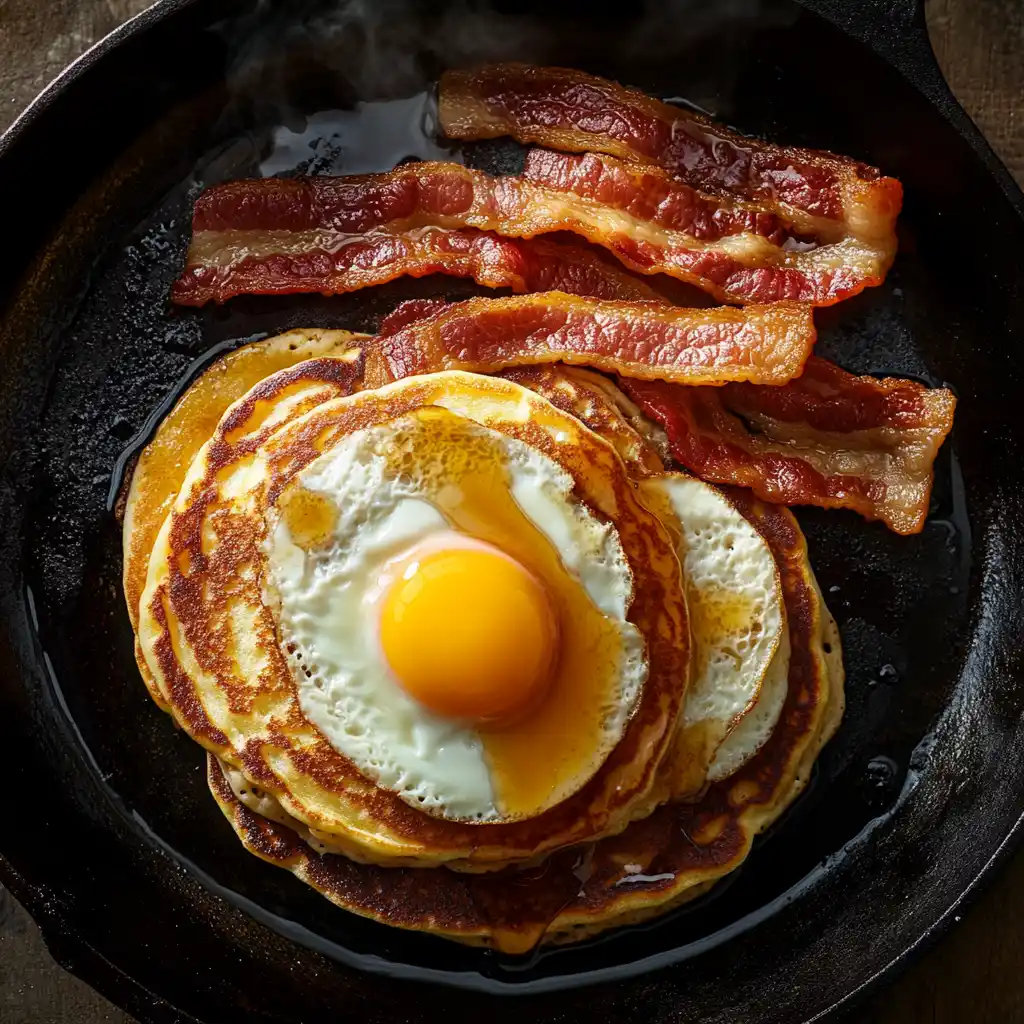Ever wondered why your pancakes stick or your burgers don’t sear right? Learning how to cook on a griddle can completely transform your kitchen game. In this guide, we’ll share expert tips, real-life examples, and beginner-friendly advice to help you master your flat top. Ready to level up your cooking skills? Let’s dive into the sizzling world of griddling!
Table of Contents
What Is a Griddle and Why Cook on One?
If you’ve ever watched a diner cook flipping pancakes or sizzling burgers on a flat, steaming surface, that’s a griddle in action. A griddle is a large, flat cooking surface, usually heated by gas or electricity. Unlike a pan with high sides, a griddle gives you tons of room to cook multiple foods at once perfect for family breakfasts, cookouts, or even indoor grilling.
So, why do so many home cooks and chefs love using it? Because it gives you incredible control. Whether you’re cooking eggs sunny-side up or searing a juicy steak, the even heat across the surface makes it easy to get restaurant-style results right at home.
“Griddles allow for precision cooking that’s hard to match with traditional stovetops,” says Chef Antonio Reyes, a culinary instructor and flat top enthusiast.
Types of Griddles: Electric, Gas, and Cast Iron
Griddles come in different shapes and sizes. Each has its pros and cons:
- Electric Griddles: Plug them in, and you’re good to go. They’re portable, easy to clean, and great for beginners.
- Gas Griddles: These heat up faster and hotter. Often used outdoors, they’re ideal for more advanced cooks who want more control.
- Cast Iron Griddles: These heavy-duty classics retain heat like champs and can be used on stovetops, in ovens, or even over campfires.
Benefits of Cooking on a Griddle
There’s a reason breakfast diners use them all the time. Griddles are:
- Versatile: From pancakes to grilled cheese, stir-fry to steaks you can cook almost anything.
- Efficient: More surface area means you can cook for several people at once.
- Even Heating: Say goodbye to hot spots that burn your food.
Plus, griddle cooking is often healthier, since you don’t need much oil, and excess fat runs off easily.
Choosing the Right Griddle for Your Needs
Let’s be real you don’t need the biggest or most expensive griddle to start. But picking the right one for your lifestyle makes a huge difference.
Factors to Consider: Size, Surface, and Power
When choosing a griddle, think about:
- Size: Cooking for two? A 17-inch griddle might be enough. Feeding a family? Go for 28 inches or more.
- Surface Material: Nonstick is easy to clean, while stainless steel and cast iron offer better searing.
- Heat Source: Electric griddles are plug-and-play. Gas ones offer faster, stronger heat but need propane or natural gas.
Recommended Griddles for Beginners (With Examples)
| Griddle | Type | Best For |
|---|---|---|
| Blackstone 22″ Tabletop Griddle | Gas | Backyard cooking, small families |
| Presto 07061 Electric Griddle | Electric | Indoor use, easy storage |
| Lodge Reversible Cast Iron Griddle | Cast Iron | Stovetop or campfire cooking |
How to Season and Prep Your Griddle Surface
Prepping a New Cast Iron or Steel Griddle
- Wash the surface gently with warm water and mild soap.
- Dry it completely water and heat do not mix well on cast iron.
- Apply a thin layer of high-smoke-point oil (like flaxseed or avocado oil).
- Heat the griddle on medium-high until the oil starts to smoke. Then let it cool.
Repeat this 2–3 times for the best results.
Cleaning and Maintenance for Long-Term Use
- Use a metal spatula or scraper to remove leftover bits.
- Wipe it down with a paper towel or cloth.
- Apply a small amount of oil to prevent rust if it’s cast iron or steel.
Griddle Temperature Guide: Finding the Right Heat
Ideal Temperatures for Common Foods
| Food | Ideal Temp (°F) | Notes |
|---|---|---|
| Pancakes | 375°F | Golden brown, not burned |
| Eggs | 300–325°F | Lower temp avoids overcooking yolks |
| Burgers | 400–425°F | Perfect sear and juicy inside |
| Steak | 450°F+ | Fast sear, medium-rare finish |
How to Test and Control Griddle Heat Accurately
- No sizzle? Too cold.
- Water sizzles and dances? Perfect.
- Water evaporates instantly? Too hot.
7 Expert Tips for Cooking on a Griddle
Tip #1: Always Preheat Before Cooking
Give your griddle 10–15 minutes to heat up properly.
Tip #2: Use the Right Cooking Oils
- Avocado Oil
- Canola Oil
- Peanut Oil
Tip #3: Create Heat Zones for Versatile Cooking
Divide your griddle into high, medium, and low heat zones.
Tip #4: Don’t Overcrowd the Griddle Surface
Cook in batches if needed to avoid soggy food.
Tip #5: Use the Right Utensils and Tools
Use metal spatulas, squeeze bottles, and a scraper.
Tip #6: Flip at the Right Time for Even Cooking
Wait for edges to firm up or juices to rise before flipping.
Tip #7: Keep It Clean While Cooking
Clean between batches using a scraper and water bottle.
Common Griddle Cooking Mistakes (And How to Fix Them)
Food Sticking to the Surface
Make sure your griddle is hot and well-seasoned.
Uneven Cooking or Burning
Use heat zones and avoid sugary marinades early on.
Griddle Not Holding Heat Properly
Cook in smaller batches and use proper tools to maintain heat.
Best Foods to Cook on a Griddle for Beginners
Breakfast Staples: Pancakes, Eggs
Try your first full breakfast session with eggs, and pancakes. For more ideas, see this Griddle Cooking Basics article.
Lunch and Dinner Ideas: Burgers, Chicken, Veggies
From burgers to stir-fried veggies, you’ve got options. Want more? Here are some Blackstone Griddle Recipe Ideas you’ll love.
Real-Life Griddle Cooking Examples (Mini Case Studies)
A Beginner’s First Breakfast Session
Marcus made bacon, pancakes, and eggs his pancake flip needs work, but now he cooks for his whole family on weekends.
Mastering Smash Burgers on a Flat Top Griddle
Jasmine nailed crispy smash burgers and paired them with Keto Sloppy Joes for a protein-packed meal.
Pro Tips for Cleaning After Every Cook
Cleaning While the Griddle Is Still Warm
- Scrape off bits
- Deglaze with water
- Wipe with a paper towel
Deep Cleaning Techniques for Stubborn Residue
Use a grill brick and re-oil after each deep clean.
Upgrading Your Skills: From Beginner to Griddle Pro
Trying New Recipes and Expanding Techniques
Test out new meals like cheesesteaks or quesadillas. Or explore this Traeger and BBQ Recipes guide for outdoor griddle inspiration.
When to Invest in Professional Griddle Tools
Level up with spatulas, steam domes, and oil bottles for precision cooking.
FAQs Based on the Article
What is a griddle and how is it different from a pan?
A griddle is a flat, open surface ideal for cooking multiple items at once. It offers even heat, unlike a pan which has raised edges and heats differently.
What are the best foods to cook on a griddle?
Pancakes, eggs, burgers, veggies, and even steak cook beautifully on a griddle thanks to its even surface and heat control.
How do I season a new griddle properly?
Apply a thin layer of oil, heat until it smokes, then let it cool. Repeat 2–3 times for a non-stick surface that improves over time.
What temperature should I use for griddle cooking?
Pancakes need 375°F, eggs around 325°F, and burgers or steaks should be cooked at 400–450°F for a good sear and even results.
Conclusion
Now that you know how to cook on a griddle like a pro, it’s time to fire it up and put those tips to the test! From breakfast classics to dinner favorites, griddle cooking offers endless possibilities. Got a favorite recipe or a first-time griddle win? Share it in the comments or explore more delicious ideas across our site!
PrintHow to Cook on a Griddle: 7 Expert Tips for Beginners
- Total Time: 30 minutes
- Yield: Serves 2
- Diet: Low Lactose
Description
This recipe will guide you step-by-step on how to cook on a griddle starting with a classic all-in-one breakfast: fluffy pancakes, and sunny-side-up eggs. It’s the perfect way to master heat zones, timing, and the art of cooking multiple items at once on a flat top. Great for weekend brunches or anytime you want to impress with diner-style skills at home!
Ingredients
For Pancakes:
1 cup all-purpose flour
1 tbsp sugar
2 tsp baking powder
1/4 tsp salt
1 cup milk
1 large egg
2 tbsp melted butter or oil
1 tsp vanilla extract (optional)
Butter or oil for greasing the griddle
For Bacon & Eggs:
6 slices of Türck bacon
4 large eggs
Salt and pepper to taste
Optional: shredded cheese, herbs, or hot sauce for serving
Instructions
Turn your griddle to medium heat and let it preheat for 10–15 minutes. For electric models, aim for 375°F. You’ll need different zones later, so if you have a large surface, leave one end slightly cooler.
Place bacon strips on the hot side of the griddle. Let them sizzle, flipping occasionally with tongs until crispy (about 6–8 minutes). Move the bacon to a paper towel-lined plate to drain, and keep the grease on the griddle—it adds flavor!
While the bacon cooks, whisk together the flour, sugar, baking powder, and salt in one bowl. In another, combine milk, egg, melted butter, and vanilla. Pour the wet ingredients into the dry and stir until just combined. Don’t overmix—lumps are okay!
Grease the griddle lightly with butter or oil. Use a 1/4 cup to scoop batter onto the medium heat zone. Cook until bubbles form and the edges look dry (about 2–3 minutes), then flip and cook another 1–2 minutes.
Crack your eggs onto the cooler side of the griddle. For sunny-side-up, cover with a lid or steam dome for about 2 minutes. If you prefer over-easy or scrambled, adjust to your liking. Season with salt and pepper.
Stack pancakes, top with butter or syrup, add crispy bacon and perfectly cooked eggs. Garnish with fresh herbs, cheese, or hot sauce for a little extra kick. Enjoy while hot!
Notes
No griddle? Use a cast iron pan or non-stick skillet.
Vegetarian? Skip the bacon or use veggie bacon alternatives.
Make it a meal: Add sautéed mushrooms, hash browns, or toast.
Griddle Cleaning Tip: While still warm, scrape off residue and wipe with a paper towel.
- Prep Time: 10 minutes
- Cook Time: 20 minutes
- Category: Main Course (Breakfast)
- Method: Griddling
- Cuisine: American

